I've got a question about filtering within a ng-repeat. But this isn't a simple question since I'm not really having a problem that needs a solution. In this case, I'm looking for the best possible answer that doesn't require a lot of code but still does the trick as to how I want it to. It will become more clear in my description.
a short introduction:
So I'm currently working on a shopping application. The shopping application has a connection with an existing PrestaShop webshop through the web service API. A rest API for PrestaShop. So after creating a customer section, products section, and a cart system, I would like to be able to update the "stock amount" of each product within the application. Many people would tell me: Well that's easy, just create a form with ng-repeat response data from the database and the possibility of updating the stock on let's say a button ng-click event.
Well I've done that but now the tricky part, and to explain I will provide some less important examples to make it more clear of what I'm asking:
The prestashop database
The prestashop database is a database that exists of over 250 tables. Among those tables are various connections through id's and attribute id's. Some simple examples are:
The
customertable has anid_addressrow which connects to theaddresstable. Within this table, all the 'customersaddress info is placed. So far, let's say updating a customer I've created a combination of update thecustomertable with thecustomer_idbut also update theaddresstable where theaddress_idis equal to theid_addressfrom the selectedcustomerwithin thecustomer` table.Products also have some linked tables. Think about prices, taxes, sizes, and colors. The
id_product_attributeis anattribute_idthat could correspond to a color or size.
As explained above the prestashop database structure is very detailed which confines to using various filters for showing the wanted data.
Using the webservice
So for using the webservice I'm using a combination of angularJS, javascript, php, and JSON. The JSON is the actual data. by using $http.get(url, options) I'm able to get the data from the database. Then for showing the data I'm using response. A example is shown below:
$http.get('config/get/getCustomers.php', { cache: true }).then(function (response) {
$scope.customers = response.data.customers.customer
});
using $scope.customers = response.data.customers.customer gives me the option to show the customer data by using, for example, a ng-repeat as in the example below
$http.get('config/get/getCustomers.php', { cache: true }).then(function (response) {
$scope.customers = response.data.customers.customer
});<script src="https://ajax.googleapis.com/ajax/libs/angularjs/1.2.23/angular.min.js"></script>
<div class="row listrow" ng-repeat="customer in customers | orderBy: customer.id">
<div class="col-lg-8">
<p class="customer" ng-bind="customer.id + ' ' + customer.firstname + ' ' + customer.lastname">
</p>
</div>
</div>In this case, the response would be empty since there is no database connection. To create a full example for testing here is some JSON data you could use from the customers table.
{"customers":{"customer":[{"id":"1","id_default_group":"0","id_lang":"0","newsletter_date_add":"0000-00-00 00:00:00","ip_registration_newsletter":{},"last_passwd_gen":"2017-10-30 09:27:03","secure_key":{},"deleted":"0","passwd":"$2y$10$eZvPTD9bkxwSfWN7qovrmee\/Den2TqZ5a6YjcGC\/lha3oU59MCjOO","lastname":"TestStefans","firstname":"John","email":"pub@prestashop.com","id_gender":"0","birthday":"0000-00-00","newsletter":"0","optin":"0","website":{},"company":{},"siret":{},"ape":{},"outstanding_allow_amount":"0.000000","show_public_prices":"0","id_risk":"0","max_payment_days":"0","active":"1","note":{},"is_guest":"0","id_shop":"1","id_shop_group":"1","date_add":"2017-04-26 14:01:31","date_upd":"2017-10-27 15:56:54","reset_password_token":{},"reset_password_validity":"0000-00-00 00:00:00","associations":{"groups":{"@attributes":{"nodeType":"group","api":"groups"},"group":{"id":"3"}}}},{"id":"2","id_default_group":"0","id_lang":"1","newsletter_date_add":"0000-00-00 00:00:00","ip_registration_newsletter":{},"last_passwd_gen":"2017-10-27 15:56:55","secure_key":{},"deleted":"0","passwd":"$2y$10$C8M6TIuzmZjP9kh06Hai8.XyuNG9WcSi9L34oXqAuidsJkoYog4WW","lastname":"Demoers","firstname":"Demoers","email":"demo@sdwebdesign.nl","id_gender":"0","birthday":"0000-00-00","newsletter":"0","optin":"0","website":{},"company":{},"siret":{},"ape":{},"outstanding_allow_amount":"0.000000","show_public_prices":"0","id_risk":"0","max_payment_days":"0","active":"1","note":{},"is_guest":"0","id_shop":"1","id_shop_group":"1","date_add":"2017-04-26 14:01:33","date_upd":"2017-10-27 15:56:55","reset_password_token":{},"reset_password_validity":"0000-00-00 00:00:00","associations":{"groups":{"@attributes":{"nodeType":"group","api":"groups"},"group":{"id":"3"}}}}]}}
So with this information here is my question:
While working on the application the following data is given within the stock_availables table.
So while using the $http.get() and the response functions I was able to create a form for updating the stock. But now take a look at the id_product_attribute. This row corresponds to a product_attribute. In this case a size or color. Now I would like to filter these results. In this case by using for example ng-if="id_product_attribute == 0" I'm able to filter in a way that only all with this id_attribute are shown. But I would like to show all of them. So also with id="1", id="2", etc. But there is where I'm wondering, is there a way to do this in a sufficient way that wouldn't require a ng-if for each id? Since there are around 50 different id_attribute's which each corresponds to a color or size. So is there a function that could get each different id and filter that in a sufficient way than using many ng-if clauses. Look at the following full code as an example.
myApp.controller('ProductsController', function($scope, $http){
$http.get('config/get/getProducts.php', {cache: true}).then(function(response){
$scope.products = response.data.products.product
});
// Stock check + view
$http.get('config/get/getStock.php', {cache: true}).then(function (response) {
$scope.stock_availables = response.data.stock_availables.stock_available
});
// Update Stock
$scope.updateStock = function(stock_available) {
var stock_id = stock_available.id;
var product_id = stock_available.id_product;
var stock_quantity = stock_available.quantity;
console.log(stock_id + product_id + stock_quantity);
// Post to the database //
};
});<script src="https://ajax.googleapis.com/ajax/libs/angularjs/1.2.23/angular.min.js"></script>
<div class="row listrow">
<div class="col-lg-12 col-md-12 col-sm-12 col-xs-12">
<ng-form name="stock">
<div ng-repeat="stock_available in stock_availables">
<div class="row full-width padding-tb-15" ng-if="stock_available.id_product == product.id && stock_available.id_product_attribute == 0" ng-repeat="product in products">
<div class="col-lg-12 form-stock-group hidden">
<input title="id" type="text" name="stockId" class="form-control" aria-describedby="" ng-value="stock_available.id">
</div>
<div class="col-lg-4">
<h5 ng-bind="product.name.language"></h5>
</div>
<div class="col-lg-3">
<h5 ng-bind="product.ean13"></h5>
</div>
<div class="col-lg-2">
<h5 ng-bind="product.reference"></h5>
</div>
<div ng-if="stock_available.id_product == product.id && stock_available.id_product_attribute == 0" ng-repeat="stock_available in stock_availables" class="col-lg-1 text-center">
<input title="stock_id" type="text" name="stock_id" class="form-control hidden" aria-describedby="" ng-model="stock_available.id" ng-value="stock_available.id">
<input title="stock_id_product" type="text" name="stock_id_product" class="form-control hidden" aria-describedby="" ng-model="stock_available.id_product" ng-value="stock_available.id_product">
<h5 title="quantity" name="stockQuantity" aria-describedby="" ng-model="stock_available.quantity" ng-bind="stock_available.quantity"></h5>
</div>
<div ng-if="stock_available.id_product == product.id && stock_available.id_product_attribute == 0" ng-repeat="stock_available in stock_availables" class="col-lg-1 text-center">
<input title="updateStockAmount" class="form-control form-control-stock" type="number">
</div>
<div class="col-lg-1 text-center">
<a ng-click="printStockLabel()">
<i class="fa fa-print" aria-hidden="true"></i>
</a>
</div>
</div>
</div>
</ng-form>
</div>
</div>I trying to create the following view:
- Product-id 1: then all sizes, colors, etc.
- Product-id 2: then all sizes, colors, etc.
Yes it is possible with writing 50 different ng-if statements but I'm asking if there is a better, easier and more sufficient way to do this?
A simple build of the dummy code can be found here
As always,
Thanks in advance!

